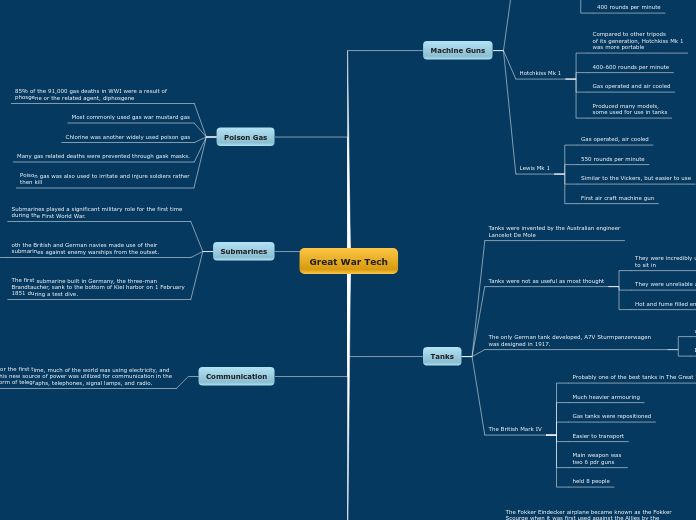Great War Tech
Machine Guns
Browning M1917
Used water cooling
over air cooling
Uses the recoil to
it's advantage
A handle attached to it
allowed for mobility
One of the most deadly weapons
used
400 rounds per minute
Hotchkiss Mk 1
Compared to other tripods
of its generation, Hotchkiss Mk 1
was more portable
400-600 rounds per minute
Gas operated and air cooled
Produced many models,
some used for use in tanks
Lewis Mk 1
Gas operated, air cooled
550 rounds per minute
Similar to the Vickers, but easier to use
First air craft machine gun
Tanks
Tanks were invented by the Australian engineer
Lancelot De Mole
Tanks were not as useful as most thought
They were incredibly uncomfortable
to sit in
They were unreliable and prone to breaking down
Hot and fume filled enviorment
The only German tank developed, A7V Sturmpanzerwagen was designed in 1917.
was used in battle from March 1918
It was manned by a crew of 18, and had eight machine guns
The British Mark IV
Probably one of the best tanks in The Great War
Much heavier armouring
Gas tanks were repositioned
Easier to transport
Main weapon was
two 6 pdr guns
held 8 people
Airrplanes
The Fokker Eindecker airplane became known as the Fokker Scourge when it was first used against the Allies by the Germans.
Not until 1914–18 that their use became widespread. At first, aircraft were unarmed and employed for reconnaissance, serving basically as extensions of the eyes of the ground commander.
Fokker Eindecker, The Fokker was perhaps the most famous fighter plane during WW.
Single-seat German fighter plane.
it introduced the synchronized machine gun and provided Germany with air superiority for a period of time during the war.
Poison Gas
85% of the 91,000 gas deaths in WWI were a result of phosgene or the related agent, diphosgene
Most commonly used gas war mustard gas
Chlorine was another widely used poison gas
Many gas related deaths were prevented through gask masks.
Poison gas was also used to irritate and injure soldiers rather
then kill
Submarines
Submarines played a significant military role for the first time during the First World War.
oth the British and German navies made use of their submarines against enemy warships from the outset.
Unrestricted submarine warfare was first introduced in World War I in early 1915, when Germany declared the area around the British Isles a war zone, in which all merchant ships, including those from neutral countries, would be attacked by the German navy.
The first submarine built in Germany, the three-man Brandtaucher, sank to the bottom of Kiel harbor on 1 February 1851 during a test dive.
Communication
For the first time, much of the world was using electricity, and this new source of power was utilized for communication in the form of telegraphs, telephones, signal lamps, and radio.
Telegraphs: They were used to communicate from the front line trenches to the officers, also from nation to nation. They were used to let leaders receive information such as troop movements, battle outcomes, and other crucial moments.
Telephone: Similar use to telegraphs. More portable and light than radios and preferred form of communication.
Radio: They were bulky and fragile. Wireless telegraphy could transmit Morse code. The problem was they were bulky and fragile, and had relatively short ranges. Later on, more robust sets were used by observers to direct artillery fire.
Signal Lamps: Used for optical communication, typically Morse code.
